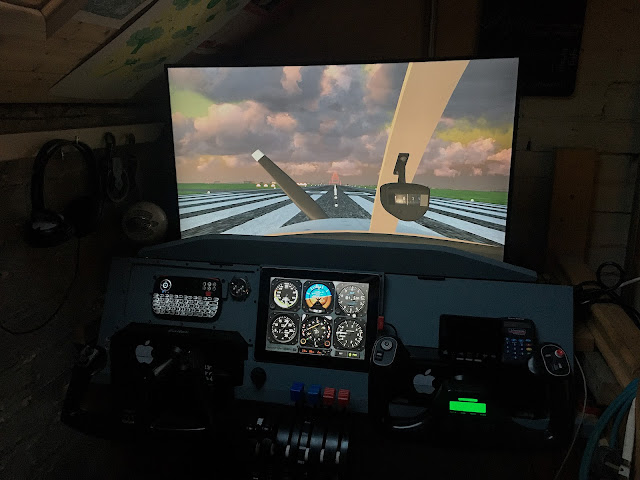Night Vision — Cockpit Lights at TK Max
 |
| Dusk at EGBE. I could not easily take a photo of the full night time flight... |
I do like to fly the simulator at night. I have a short duration circular route from Coventry to Birmingham and back which is flown regularly and sometimes without using any instruments at all — just gut instinct!
Now this might sound crazy but really, flying a routine route in total darkness without instruments is actually quite easy because visual navigation is uncluttered. Engine control is by sound, altitude by visual cues out the windows, attitude by reference to the far horizon and heading by knowing the routine route well.
There's the two illuminated runways just 12 miles apart as the crow flies. I take off from Coventry heading South West. Just as soon as I reach a couple of thousand feet I can see Birmingham airport very clearly out of my right window because the runway is aligned North West and so the runway lights there are compressed together visually.
I then level off, turn right and position the plane for approach.
The return journey is somewhat trickier because it involves a long, smooth right hand turn while climbing out of Birmingham in order to get the plane heading south-east and accurately positioned for final approach to Coventry. This is not so easy because visually, the runway lights are strung out across the horizon and do not come together as a single point block of light until I have made the last right hand turn.
There is absolutely no cruise to speak of.
It's all action, seat of the pants, for all of the way.
"I go up-tiddly-up-up,
I go down-tiddly-down-down!"
Whilst browsing TK Max I spied an interesting light bulb or rather this light bulb's companion object. This was a little rectangular box with coloured buttons which the packaging claimed would instruct the bulb as to which wavelength of light it would emit. It was just a tenner and so I bought it thinking that it would be an aid in night flying.
To my surprise it really worked!
True night vision is something that few people ever experience because just when it starts to arrive they'll switch on a light bulb so that they can see their way. This action destroys night vision utterly. Bright white light is lethal to it to the extent that should the light bulb fail, then a person is effectively blind until night vision returns — which requires about twenty to thirty minutes immersion in full darkness to achieve.
I used to do a lot of night fishing at low tide in very remote places, such as the mudflats of Mersea Island and Point Clear on the Essex coast. Out there alone without any lamp to aid me I would successfully fish (with all the fiddling that might require!) by way of night vision alone.
It's not an easy thing to explain.
I would depart the illumination of the building and roads along the beach and set out into the void beyond. As the beach light diminished the night vision intensified, when a brief period of disorientation was entered. However, at half a mile distance from civilisation and in full darkness at the water's edge I always found that I could see perfectly well.
The hours passed, I fished happily, and when the tide eventually turned against me I would walk back to the beach laden with a brace of bass.
This capacity of the eye to adjust and cope with apparent complete darkness is remarkable and was once essential—and not so very long ago—to the very survival of the human race. Trust me, there is light enough under most normal night-time situations. It's just very low level indeed. Just so long as that very low level is maintained you can actually see quite well.
If it is disrupted by a flash of white light, however, then it is inky black all around once more!
If light is required, as it would be in the cockpit of a plane, then it must be red light or green light for best and of low intensity. Apparently, there is a move to low intensity greenish-blue in modern airline cockpits which is seen as the best compromise to maintain sufficient night vision adaptation and allow clear vision of all instruments and switches.
I'm experimenting with my night flight set up. The room is pitch black, the I-Pad dimmed to near lowest settings but the backlit keyboard I might have to take apart and wire in a red LED or somehow paint with red lacquer over the illuminated keys. The monitor is also dimmed as much as is needed because the simulated runway lighting is, I feel, a tad too bright for realism.





Comments
Post a Comment